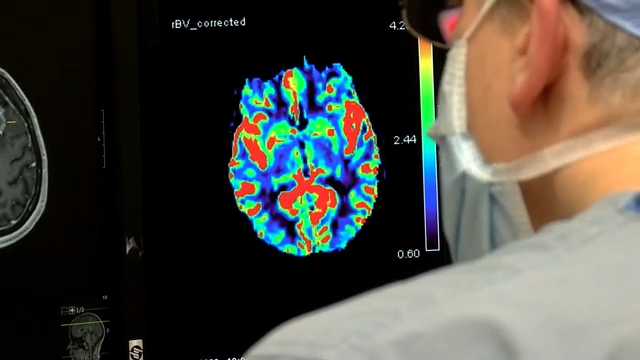PITTSBURGH, Pa. (Ivanhoe Newswire)— For about half of all people with epilepsy, medication controls the seizures … but for others, once medication fails, brain surgery becomes the best option. Now, for the first time in the U.S., an epilepsy expert and a team of skull base surgeons have developed a new approach.
Thirty-nine-year-old Joey Chasko loves to bake with mom Linda. Some days, Joey needs help with details. He’s had seizures since birth, but two years ago, they got worse.
“They started to come more often, about, like, every two or three weeks,” recalled Joey.
Even with three daily medications twice a day, nothing stopped the seizures. Brain surgery was the next step.
“It was his choice, but at the same time, it was a scary decision to make,” explained Joey’s mom, Linda Chasko.
Joey’s doctor thought he would be the perfect candidate for a new approach pioneered by a team of surgeons at the University of Pittsburgh Medical Center. For the past decade, surgeons have performed epilepsy surgery through a standard craniotomy. Now, the surgeons wanted a better angle to visualize the brain.
“Instead of going through the nose, we went through what we call the gingival labial fold, which is inside the mouth,” illustrated Jorge Gonzalez-Martinez, MD, PhD, a neurosurgeon at University of Pittsburgh Medical Center.
By going through the inside of the lip, surgeons leave more of the brain intact.
“Now, we are removing small areas, as I said, size of an olive, perhaps the size of a cherry, very localized, very focal,” Dr. Gonzalez-Martinez described.
Joey had some facial numbness, but no seizures. He’s looking forward to some day being completely medicine-free.
“And I could get back to a regular normal life and not have to worry about anything,” Joey shared.
The UPMC team has performed this new surgery on two other patients in addition to Joey. Doctors say all three are recovering well. The new procedure has now been dubbed the Sublabial Pittsburgh Endoscopic Temporal Lobe—or “SPETL” approach.
Contributors to this news report include: Cyndy McGrath, Executive & Field Producer; Kirk Manson, Videographer; Roque Correa, Editor.
To receive a free weekly e-mail on Medical Breakthroughs from Ivanhoe, sign up at: http://www.ivanhoe.com/ftk
Sources:
https://www.cdc.gov/epilepsy/data/index.html
https://www.upmcphysicianresources.com/news/091820-epilepsy-surgery
MEDICAL BREAKTHROUGHS
RESEARCH SUMMARY
TOPIC: SPETL: BRAIN SURGERY THROUGH THE LIP!
REPORT: MB #4865
BACKGROUND: Approximately 3.5 million people in the United States have epilepsy with around 50 to 70 percent being able to successfully control their seizures with medication. This leaves 30 to 40 percent of patients that cannot have seizures controlled with medication, and therefore look toward surgery in order to help control their seizures. The craniotomy is the traditional way of performing surgery to help treat seizures. The surgery removes areas in the brain that are not completely responsible for the seizures in order to get access to the areas that need to be treated. The downfall of this treatment is that the removal of unnecessary areas to treat seizures could cause problems for the patients which may cause additional distress, mainly memory and cognition.
DIAGNOSING: A doctor will review a person’s symptoms and medical history and may order several tests to diagnose epilepsy and determine the cause of seizures. Diagnostic reviews may require a neurological exam to test a person’s behavior, motor abilities, mental function and other areas to diagnose their condition and determine the type of epilepsy they may have. A person being diagnosed for epilepsy may also be required to have a blood sample taken to check for signs of infections, genetic conditions or other conditions that may be associated with seizures.
(Source: https://www.mayoclinic.org/diseases-conditions/epilepsy/diagnosis-treatment/
NEW TECHNOLOGY: Most recently, treating epilepsy seizures can be done by using laser ablations, a type of surgery that uses light and heat to destroy (ablate) a small part of the brain that causes seizures. This approach allows surgeons to perform resections of the major structures of the temporal lobe through the face which allows for a minimally invasive procedure where there are no craniotomies or openings in the skull. The benefit to this surgery method is that there is no need to expose larger areas in the brain and remove them in order to get access to the areas that need to be treated. Now, the surgery can be done just in the areas that require treatment.
FOR MORE INFORMATION ON THIS REPORT, PLEASE CONTACT:
SHEILA DAVIS
412-313-6070
If this story or any other Ivanhoe story has impacted your life or prompted you or someone you know to seek or change treatments, please let us know by contacting Marjorie Bekaert Thomas at mthomas@ivanhoe.com




